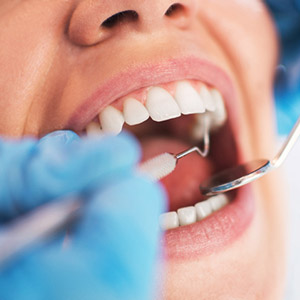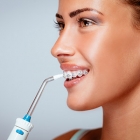
If you've ever had a run-in with cavities, you know the drill (no pun intended): After getting a local anesthetic for pain, the dentist removes any decayed dental tissue, as well as some healthy tissue, and then fills the cavity to restore the tooth. It's an effective treatment protocol we've been using for well over a century.
It does, however, have its drawbacks. For one, although necessary, removing healthy dental tissue can weaken the overall tooth structure. The dental drill used during the procedure is also unpleasant to many people: Although it doesn't cause any pain thanks to the anesthetic, the sounds and pressure sensations associated with it can be unsettling.
But advances in dental tools, technology and techniques are addressing these drawbacks in traditional tooth decay treatment. In other words, treating a tooth with cavities today is taking on a lighter touch. Here are 3 reasons why.
Earlier detection. The key to effective treatment is to find tooth decay in its earliest stages. By doing so, we can minimize the damage and reduce the extent of treatment needed. To do this, we're beginning to use advanced diagnostic tools including digital x-rays, intraoral cameras and laser fluorescence to spot decay, often before it's visible to the naked eye.
Re-mineralizing enamel. One of the advantages of early detection is to catch tooth enamel just as it's undergoing loss of its mineral content (demineralization) due to contact with acid. At this stage, a tooth is on the verge of developing a cavity. But we can use minimally invasive measures like topically applied fluoride and CPP-ACP (a milk-based product) that stimulates enamel re-mineralization to prevent cavity formation.
Less invasive treatment. If we do encounter cavities, we no longer need to turn automatically to the dental drill. Air abrasion, the use of fine substance particles under high pressure, can precisely remove decayed material with less loss of healthy tissue than a dental drill. We're also using newer filling materials like composite resins that don't require enlarging cavities as much to accommodate them.
These and other techniques—including laser technology—are providing superior treatment of tooth decay with less invasiveness. They can also make for a more pleasant experience when next you're in the dentist's chair.
If you would like more information on effectively treating dental disease, please contact us or schedule an appointment for a consultation. You can also learn more about this topic by reading the Dear Doctor magazine article “Minimally Invasive Dentistry.”

If you're intrigued by the strange and bizarre, here's one to pique your interest: geographic tongue. It's a rare condition that causes the appearance of red patches on the tongue surface, surrounded by grayish-white borders, and which look a lot like continents on a map (hence the name). But although it may look odd, geographic tongue won't harm your health.
The condition is also known as benign migratory glossitis, so named because it's not cancerous and the patches seem to move or “migrate” around the tongue surface. The most common causes are thought to be stress or hormonal disruptions in those predisposed to the condition. Many researchers believe zinc or vitamin B deficiencies in the body contribute to its occurrence. It also seems more prevalent among non-smokers and pregnant women, as well as occurring as a family trait.
The red patches are created by the temporary disappearance of some of the papillae, tiny bumps on the tongue's top surface. The patches can abruptly appear during a flareup and then disappear just as suddenly. But as “angry” as the patches may look, geographic tongue is not considered a health danger. It isn't normally painful, although people can experience stinging or numbing sensations emanating from the patches that can be mildly uncomfortable.
Because it's also rare, you're not likely to encounter it personally. But if you or a loved one does begin to notice red patches on the tongue, there are a few things you can do to lessen any accompanying irritation. For one, cut out foods like tomatoes, citrus fruits, eggplant, mint or highly spicy or acidic foods, all of which have been known to increase discomfort. You might also avoid astringents like alcohol or mouthwashes that likewise irritate the patches when they occur.
Although geographic tongue can't be cured, your dentist can help you manage symptoms when they arise with the help of prescribed anesthetic mouthwashes, antihistamines or steroid lozenges. These not only can help lower any discomfort or irritations, they may also lessen the duration of a flareup.
For the most part, geographic tongue usually causes more embarrassment than physical discomfort. But with a little help from your dentist, you can keep it to a minimum. Geographic tongue may be odd, but it's nothing to worry about.
If you would like more information on geographic tongue, please contact us or schedule an appointment for a consultation. You can also learn more about this topic by reading the Dear Doctor magazine article “Geographic Tongue: No Cause For Alarm.”

If we were playing word association with the term “oral hygiene,” you'd probably answer “brushing.” And you would be right—brushing cleans tooth surfaces of accumulated bacterial plaque, a thin biofilm most responsible for dental disease.
But brushing is only half of the oral hygiene equation: You also need to remove dental plaque between teeth where brushing can't reach. And, that requires that other practice—flossing.
Unfortunately, brushing is more popular than its hygienic sibling because many people find traditional thread flossing more difficult and messier than brushing. That can make it tempting to skip flossing—but then you're only getting half the benefit of oral hygiene for reducing the risk of tooth decay or gum disease.
There is, however, a way to floss that doesn't involve a roll of thread: oral irrigation. This form of flossing uses a countertop device that directs a pressurized spray of water between teeth through a handheld wand. The directed spray loosens and then flushes away accumulated plaque.
Oral irrigators (also known as water flossers) have been an important tool for decades in dental offices, and have been available for home use since the 1960s. In the last few years, though, the devices have become more compact and easier to use. More importantly, studies have shown they're as effective in removing between-teeth plaque as regular flossing.
These irrigation devices are especially useful for people wearing braces. The attached brackets and wires make it extremely difficult to maneuver flossing thread between teeth. Because of this (as well as similar difficulties in brushing), patients are more susceptible to dental disease while undergoing orthodontic treatment.
But a 2008 study showed that oral irrigators are quite effective for braces wearers in removing between-teeth plaque. It found those who used an irrigator after brushing removed five times the amount of plaque than those that only brushed.
Even if you're not wearing braces, you may still find an oral irrigator to be a useful flossing alternative. Speak with your dentist for recommendations on what to look for in an oral irrigator and tips on how to use it. It could make a positive difference in your dental health.
If you would like more information on how best to keep your teeth and gums clean, please contact us or schedule an appointment for a consultation. You can also learn more about this topic by reading the Dear Doctor magazine article “Cleaning Between Your Teeth.”

Actor Zac Efron has one of the top smiles in a business known for beautiful smiles. Bursting on the scene in 2006 at age 18 in High School Musical, Efron has steadily increased his range of acting roles. He recently starred as Ted Bundy on Netflix, wearing prosthetics to match the notorious serial killer's crooked teeth.
With his growing fame, Efron's attractive smile has become one of his more memorable attributes. But it wasn't always so. Before Hollywood, Efron's smile was less than perfect with small, uneven teeth and a gap between his top front teeth. Before and after pictures, though, make it quite apparent that the actor has undergone a significant smile makeover.
While fans are abuzz on the 411 regarding his dental work, Efron himself has been hush-hush about his smile transformation. We won't join the speculation: Instead, here are a few possible ways you can get a more attractive smile like Zac Efron.
Teeth whitening. A single-visit, non-invasive teeth whitening procedure can transform your dull, stained teeth into a brighter, more attractive smile. Although the effect isn't permanent, it could last a few years with a professional whitening and good oral practices. Having it done professionally also gives you more control over the level of shading you prefer—from soft natural white to dazzling Hollywood bright.
Orthodontics. Like Efron, if your teeth aren't quite in proper alignment, straightening them can make a big difference in your appearance (and your oral health as well). Braces are the tried and true method for moving teeth, but you may also be able to choose clear aligner trays, which are much less noticeable than braces. And don't worry about your age: Anyone with reasonably good dental health can undergo orthodontics.
Bonding. We may be able to correct chips and other slight tooth flaws with durable composite resins. After preparing your tooth and matching the material to your particular color, we apply it directly to your tooth in successive layers. After hardening, the unsightly defect is no more—and your smile is more attractive.
Veneers. Dental veneers are the next step up for more advanced defects. We bond these thin, custom-made layers of dental porcelain to the front of teeth to mask chips, heavy staining and slight tooth gaps. Although we often need to permanently remove a small amount of tooth enamel, veneers are still less invasive than some other restorations. And your before and after could be just as amazing as Zac Efron's.
Improving one's smile isn't reserved for stars like Zac Efron. There are ways to correct just about any dental defect, many of which don't require an A-lister's bank account. With a little dental “magic,” you could transform your smile.
If you would like more information about how to give your smile a boost, please contact us or schedule a consultation. To learn more, read the Dear Doctor magazine articles “The Magic of Orthodontics” and “Porcelain Veneers.”

The subject of allergies covers a wide swath in medicine. Among other things, people have allergic reactions to animal fur, various foods and plant pollen. The effects are equally wide-ranging, anything from a mild rash to anaphylaxis, a life-threatening shutdown of the body's vital systems.
Approximately 5% of people are also allergic to various metals including nickel, cobalt, chromium and gold. Reactions to metal can occur when an allergic person comes in contact with items like jewelry, clothing or even mobile phones. There's even a chance of a metal allergy reaction from certain kinds of dental work.
It's unlikely, though, that you should be concerned if you're considering dental treatment or cosmetic work to upgrade your smile. Although allergic reactions like inflammation or a rash have been known to occur with amalgam “silver” fillings, it's quite rare. It's even less of a concern since “tooth-colored” materials for fillings are now outpacing the use of amalgam fillings, which are used in out-of-sight back teeth.
Of course, metal is used for other dental treatments besides fillings, including the most popular of tooth replacement systems, dental implants. An implant is essentially a metal post, usually made of pure titanium or a titanium alloy, which is imbedded into the jawbone. Even so, there's little chance you'll develop an allergic reaction to them.
For one thing, titanium is highly prized in both medical and dental treatments because of its biocompatibility. This means titanium devices like prosthetic joints and implants won't normally disrupt or cause reactions with human tissue. Titanium is also osteophilic: Bone cells readily grow and adhere to titanium surfaces, a major reason for dental implants' long-term durability.
That's not to say titanium allergies don't exist, but their occurrence is very low. One recent study detected a titanium allergy in only 0.6% of 1,500 implant patients who participated.
At worst, you may need to consider a different type of tooth replacement restoration in the rare chance you have a titanium allergy. More than likely, though, you'll be able obtain implants and enjoy the transformation they can bring to your smile.
If you would like more information on allergic reactions and dental restorations, please contact us or schedule an appointment for a consultation. You can also learn more about this topic by reading the Dear Doctor magazine article “Metal Allergies to Dental Implants.”
This website includes materials that are protected by copyright, or other proprietary rights. Transmission or reproduction of protected items beyond that allowed by fair use, as defined in the copyright laws, requires the written permission of the copyright owners.
